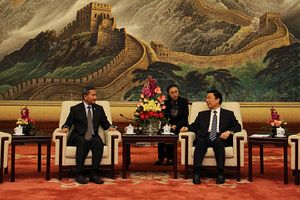Singapore has suggested the expansion of a key naval protocol to defuse tensions in the South China Sea, the country’s new foreign minister said yesterday on the final day of his maiden voyage to China.
While Singapore is not a claimant state in the South China Sea disputes–which involve China, Taiwan, Brunei, Malaysia, the Philippines and Vietnam–the city-state is an interested party since tensions have effects on peace and stability, freedom of navigation and overflight, as well as trade—all of which affect its interests (See: “Does ASEAN Have a South China Sea Position”). Singapore is also the current coordinator for ASEAN-China relations in a year that has already gotten off to a rough start in the South China Sea with China stationing military equipment in the Paracels and continuing its construction in the Spratlys.
During his two-day visit to Beijing this week, Singapore’s foreign minister, Vivian Balakrishnan, said that Singapore had proposed the expansion of the Code for Unplanned Encounters at Sea (CUES)–a series of protocols for the safety of naval vessels–as one of several interim steps to defuse tensions in the South China Sea. He also said that China had indicated that it is an idea worth exploring.
“It is, in a sense, some rules of engagement which will prevent untoward accidents or miscalculations which will lead to tensions and conflict at sea. And we’ve suggested expanding this to cover both naval vessels and coast guards,” Balakrishnan said.
As Balakrishnan himself correctly noted, CUES itself not new. As I’ve noted previously, CUES was negotiated and signed at the Western Pacific Naval Symposium back in 2014. Since then, various countries have been using CUES in exercises as a practical measure to reduce miscalculation at sea, including the United States and China as well as Japan and the Philippines.
Singapore as well as several other countries have also previously suggested–both privately and publicly–expanding CUES to cover disputes areas and non-military vessels. Last December, Malaysia’s new naval chief told a regional security forum that CUES should be expanded to cover disputed areas in the South China Sea as well as “other maritime agencies, especially the coast guards” (See: “Malaysia Wants Expanded Naval Protocol Amid South China Sea Disputes”).
Just last month, Vice Admiral Joseph Aucoin, the commander of the Japan-based U.S. Seventh Fleet, also said in Singapore that expanding CUES to cover non-military ships would be a wise move, particularly since confrontations in the South China Sea have involved non-military vessels–including large Chinese coast guard ships and smaller ones manned by militia organized by Beijing (See: “China is Building a New South China Sea Fleet for its Maritime Militia”).
It is also not surprising that China sees this as an idea worth exploring. After all, Beijing mentioned at its inaugural meeting with ASEAN defense chiefs last October that it would hold a joint training on CUES in 2016 in the South China Sea (See: “China Reveals New Proposal to Boost Defense Ties With ASEAN”).
While Balakrishnan did point out Singapore’s role in floating the proposal of expanding CUES in the South China Sea, he also said the city-state was cautious to avoid overplaying its role.
“I see us as just being one conduit to lower temperatures and to seek peaceful resolution of differences,” he said. “I don’t think we should overplay our role either because we can’t solve all the problems in the world. But we do our best. We take advantage of the fact that people know us, hopefully people trust us, people rely on us, and we will do our best.”
According to a statement by Singapore’s foreign affairs ministry on his visit, Balakrishnan relayed concerns expressed by ASEAN foreign ministers during their retreat in Laos on February 27 (See: “ASEAN ‘Seriously Concerned’ By China’s South China Sea Behavior”).
“Minister Balakrishnan also conveyed the concerns expressed by the ASEAN Foreign Ministers during the ASEAN Foreign Ministers’ Retreat in Laos on 27 February 2016, as well as the importance of non-militarization and self-restraint in the conduct of activities to lower the temperature and prevent incidents in the South China Sea,” the statement said.
Balakrishnan has been Singapore’s foreign minister since last October after Singapore’s Prime Minister Lee Hsien Loong unveiled a new cabinet following the ruling People’s Action Party’s landslide victory in the September 11 elections. During his visit to Beijing, he met with a range of Chinese officials, including his counterpart Wang Yi and State Councilor Yang Jiechi.
In his conversations with Chinese officials as well as in an op-ed on the Singapore-China relationship released in conjunction with his visit, Balakrishnan stressed that ASEAN and China should fully abide by the Declaration on the Conduct of Parties in the South China Sea and expeditiously conclude a Code of Conduct (which Beijing has been dragging its feet on).

































